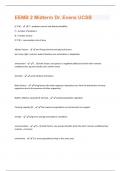Exam (elaborations)
MNE3701 Assignment 5 Semester 2 2024 | Due 25 October 2024
- Institution
- University Of South Africa (Unisa)
MNE3701 Assignment 5 Semester 2 2024 | Due 25 October 2024. All questions answered. Having acquired sufficient knowledge and skills on entrepreneurship and small business management, you must demonstrate practical competencies in managing business’s assets and risks. Think of any business you wou...
[Show more]












